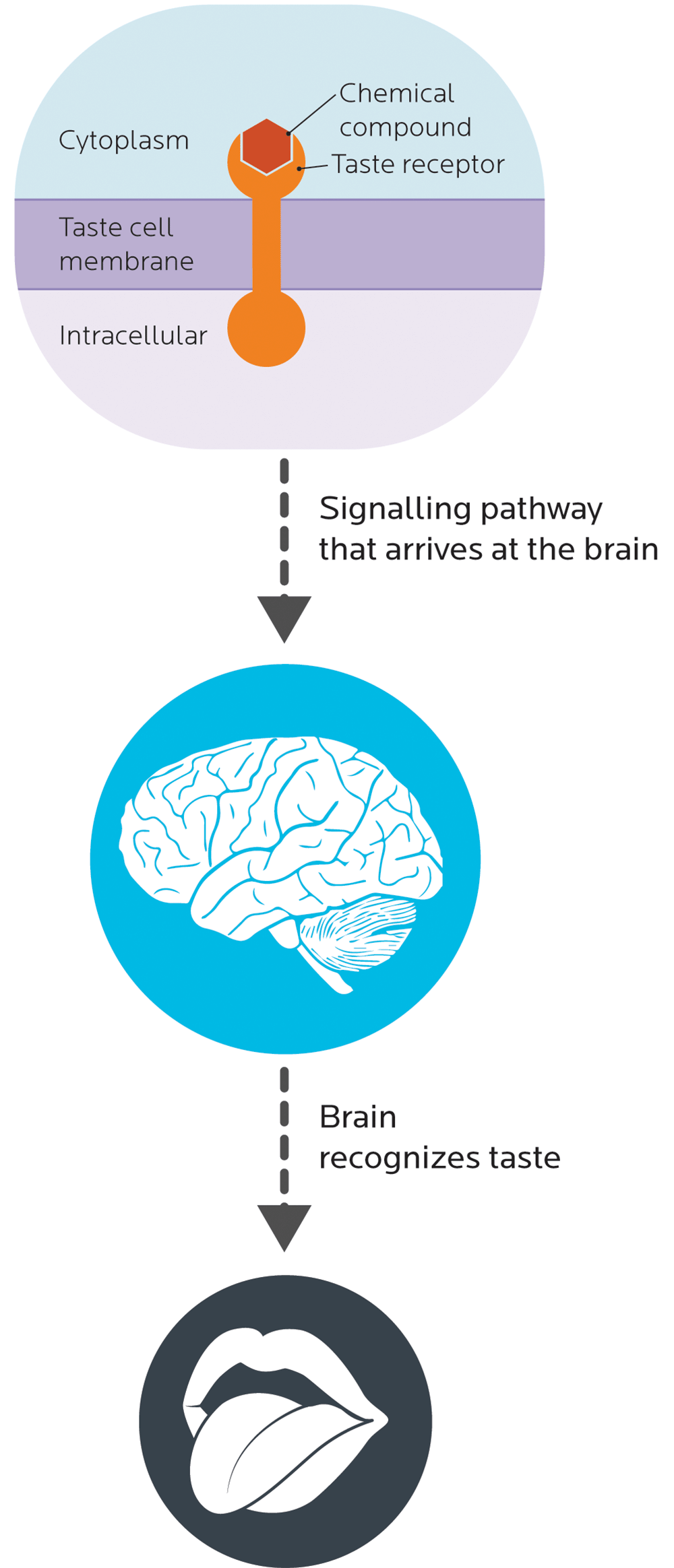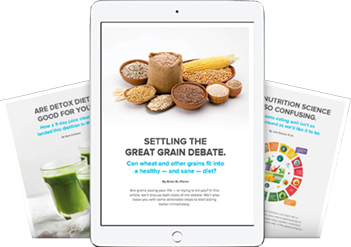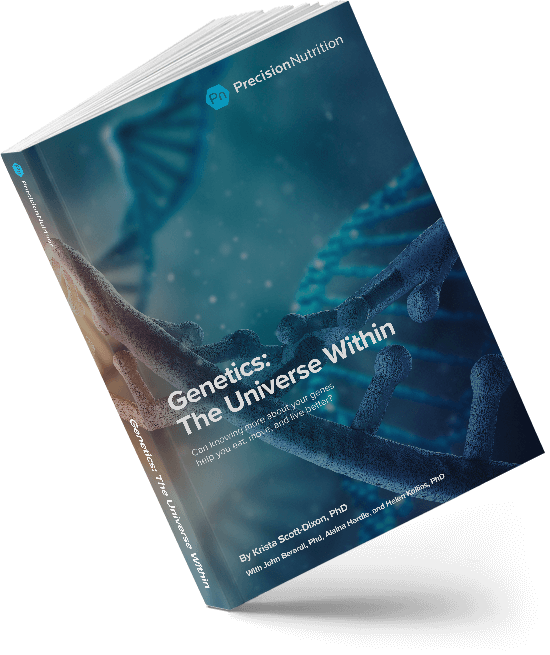Chapter 8
What we found: Food preferences
What you’ll learn in this chapter
In this chapter, we’ll look at:
- some of the genetic and environmental factors that can affect food choices and preferences, such as whether we like:
- sweet tastes;
- fatty tastes;
- bitter tastes; or
- cilantro (coriander); and
- what genetic testing can tell us (or not) about food preferences.
Two important points to keep in mind:
- While science is cool, and we have some interesting genetic findings and areas for further exploration, we still know comparatively very little.
- Just because a genetic test can tell you what kinds of tastes you might prefer doesn’t mean that it can tell you the “perfect” diet or supplement for you.
As you read this chapter, remember our usual caution:
As with most preferences, health risks, and genetic traits, there are many complex, intersecting factors.
There is almost never one single gene that inevitably leads to a given result.
Any genetic data we share are simply clues for further exploration.
Why is there no single “best” diet or exercise plan?
At PN, we’ve long been interested in the idea of a “best diet” — debunking it, that is.
Over the years, we’ve explored human variation and why the concept of a single, one-size-fits-all “perfect diet” doesn’t make sense.
You can read more about that here.
Non-genetic factors can affect nutrition and food choices.
There are many non-genetic factors to consider in developing an “optimal” nutrition plan for each one of our clients.
For instance, we might ask:
- What do people know about nutrition?
- What can people do? (For instance, can they cook?)
- What can people do consistently? What habits can they stick to realistically and reliably?
- What else is happening in their lives? Are they busy? Working? Students? Parents?
- What’s around them? Do they have access to fresh food?
- How fit and active are they?
- If they’re active, in what sports or activities?
- How old are they? Babies? Seniors? Teens?
- What do they like and enjoy?
- What’s their cultural and social environment?
- What are their food traditions and values?
- How healthy is their gastrointestinal tract right now?
- What about their dental health?
- How is their overall health right now? Are they injured or ill?
- What emotional associations do they have with food?
- Etc.
Genetic factors can affect nutrition and food choices too.
For example:
Genetic factors may affect taste preferences.
This may be because:
- of the physical structures of tasting (such as how many taste buds we have, or how densely packed they are);
- of how we process those tastes at the molecular signaling level (for instance, whether we can chemically sense some types of compounds); and
- we are naturally predisposed to find some tastes “good” or “compelling”.
Genetic factors may affect what foods we can tolerate.
Does food feel physically good… or bad?
When you drink milk or eat ice cream, do your intestines regret it?
What about a few slices of bread, or some high-fructose fruit?
Along with other factors, such as the health of our gastrointestinal tract, our genetic makeup can affect which foods we digest well, and which ones we don’t.
We’ll look at food tolerance in Chapter 9.
Genetic factors may affect how we process nutrients.
In Chapter 6, we saw how various forms (aka polymorphisms) of the cell receptor for vitamin D, and genes coding for proteins involved in vitamin D metabolism and transport, may affect our risk for chronic diseases or whether we need to supplement additional vitamin D (if we aren’t getting enough from sunlight).
Vitamin D isn’t the only nutrient whose digestion, absorption, or use can be affected by genetic variation.
We’ll look more at nutrient use in Chapter 10.
In this chapter, we’ll start with food preferences.
Why do we prefer particular tastes?
Our taste preferences are strongly shaped by the culture and social milieu that we grew up in.
If you grew up Anglo in North America, you probably have particular taste preferences and food routines. For instance, breakfast for you might be toast or cereal with orange juice. You probably like things to be sweet, and you might not like too many things that are bitter or pungent.
Meanwhile, in Japan, you might be enjoying fish and miso soup for breakfast. In Sweden, you might be tucking into a smoked herring and dark rye bread smorgås (open-faced sandwich) with strong coffee. In Nigeria, you might be longing for your grandmother’s traditional akamu, or fermented sour corn porridge.
Tastes are malleable. They can change.
We can discover (and learn to love) new tastes and textures with travel — whether we literally go to new places, or simply explore the world of cuisine around us.
Genetic data suggest that to some degree, our tastes are also shaped by heredity.
If you have had a lifelong preference for sugar, or a lifelong hatred of cilantro (coriander), or struggle to enjoy vegetables… there may be a reason.
How does tasting work?
Taste receptors
Taste receptors, like other receptors that we’ve learned about, are proteins that bind to particular molecules.
Like all sensory input (such as sights, smells, and sounds), perceiving and interpreting taste requires an interaction between one or more specialized receptors and our brains.
A chemical must interact with a taste receptor, which sends a signal to our brains. Our brains then decide whether the taste is good, bad, or something to ignore completely.
- TAS1R receptors detect sweetness.
- TAS2R receptors detect bitterness.
- TRPV1 receptors detect “heat” (e.g., from chili peppers).
- CMR1 receptors detect “cold” (e.g., from mint).
- Other tastes (salty and sour) are detected by ion channels, such as the epithelial sodium channel (ENaC), or the acid-sensing ion channels (ASICs), which can tell how much of a substance (such as salt) is in a solution.
- Olfactory receptors in our nose add information from what we smell, which also affects our brain’s perception of taste.

We can vary in:
- How many taste receptor proteins we have, as well as the physical structures of our taste buds.
- How sensitive they are (or how much of a certain chemical signal they require to “get the message”).
- How our brains interpret the information they get from our receptors.
- Where these receptors are — in addition to those in our mouths, we actually have “taste” receptors throughout our gastrointestinal tract, including in our nasal epithelia, our tracheas, our stomachs, our bile ducts, and our small intestines. These types of receptors even show up in the skin, thyroid, bladder, testes, and bone.
Taste receptors aren’t just for tasting.
They may, for instance, be involved in:
- immunity;
- our response to prescription drugs;
- appetite control (for instance, TAS2R receptors can communicate with hormone-secreting cells in our GI tract like those that produce cholecystokinin (CCK), one of our satiety hormones);
- glucose homeostasis; or
- whether we like to drink alcohol or smoke.
Again, many of these factors are shaped by our genes, which means that genes (to some degree) can affect what foods we instinctively like, or avoid.
Some examples:
- Variants in the TAS2R16 gene can affect how we perceive the bitterness of certain plant compounds and our preferences for alcohol.
- A TAS2R19 variant may predict how well we taste and/or like grapefruit or quinine (a bitter extract used in some soft drinks like Brio, or the tonic water in your cocktail)
- TAS2R31 polymorphisms seem to be related to our perception of artificial sweeteners such as saccharin and acesulfame-K. TAS2R4 and TAS2R14 variations can affect whether we notice a yucky aftertaste to steviol glycosides, some of the active compounds in stevia.
- Speaking of sweeteners, humans can taste many artificial sweeteners, such as aspartame, neotame, cyclamate, and neohesperidin dihydrochalcone. We can also taste sweet-tasting proteins, such as brazzein, monellin, and thaumatin, that other species like mice can’t.
- Gustin is a protein that promotes taste bud development. Variations in the CA6 gene that codes for gustin can affect “super-tasting”, which we’ll look at below.
There are many genes that contribute to taste perception and food preferences.
And there can be many genetic variations within one person, and between people, which means that we can’t definitely say what a person’s preferences or taste experiences will be.
Do you like sweetness?
Most of us naturally prefer sweetness.
This makes evolutionary sense. Sweetness usually meant something was good to eat and energy-dense (like honey or fruit). Even newborn babies typically prefer sucrose (sugar) solutions to water.
So what are a few genetic contributions to sweet taste preference?
TAS1R2 and TAS1R3
Two genes — TAS1R2 and TAS1R3 — code for taste receptor proteins that react to sweetness.
In one study in a European population, researchers looked at two types of sweetness preference:
- how sweet something was (intensity); and
- how much people liked it.
They found that genetic variance didn’t explain people’s preference for intensity, but did partly correlate (between 30-50%) to people’s liking for sweetness.
FGF21
FGF21 codes for fibroblast growth factor 21, a protein that’s involved in many metabolic processes, including glucose uptake and the adaptive response to starvation.
According to crowd-sourced 23andMe data, about 120,000 people of European descent with the AA (adenine-adenine) variation in the rs838133 SNP of FGF21 were a little more likely to prefer sweet tastes to savory or salty tastes, compared to people with AG (adenine-guanine) or GG (guanine-guanine).
Interestingly, almost none of us surveyed at PN had the AA genotype for the FGF21 variant. We were about half-and-half AG or GG.
Indeed, the folks who had GG are “meh” about sugar. One bite of it and they’re bored.
However, John, who’s an AG, says he’s a “dessert monster”.
Fun factoid!
Note from Krista: This is true. I have personally witnessed John’s passionate love for cookies.
The FGF21 gene and its protein product don’t just affect whether we’re more likely to reach for the candy dish. They also play other roles in metabolism, and may have relationships with metabolic health. We’ll look more at FGF21 in Chapter 10.
The short version, though, is that sweet taste preference is likely just one small part of a much larger system of genetic and epigenetic metabolic regulation.
SLC2A2 and GLUT2
As we saw in the chapter on metabolism, glucose transport in the body can affect health. Research suggests that it can also affect taste preferences.
After we eat something sugary or starchy and break it down to glucose, we need to move it somewhere to do a metabolic job (such as storing nutrients in cells). This is done by a family of glucose transporter proteins known as GLUTs.
The SLCA2 gene codes for one of these GLUT transporters, GLUT2, which is found in the pancreas, liver, small intestine, kidney, and brain. Because of these locations, it’s probably involved in local glucose transport as well as sensing overall glucose levels throughout our bodies.
The rs5400 SNP of SLC2A2 may be related to sweet taste preferences.
Two studies of prediabetics as well as young, healthy people in their 20s found that in both populations, people with a CT (cytosine-thymine) or TT (thymine-thymine) at rs5400 ate more sweet foods. These variants of SLCA2 rs5400 and another SNP, rs5393, are also associated with a higher risk of Type 2 diabetes.
What did we find in our sample?
You may remember our friend, the FTO gene, from Chapter 7 about body weight.
Along with the FGF21 SNP rs838133, the FTO SNP rs1421085 is associated with sweet taste preference.
Here’s what we found in our sample:
| FTO var rs1421085 | FGF21 rs838133 | ||
| CC – higher odds of sweet preference | 16% | AA – higher odds of sweet preference | 3% |
| CT – typical odds | 53% | AG – typical odds | 50% |
| TT – lower odds of sweet preference | 31% | GG – typical odds | 47% |
| How do you feel about sugar? | |
| I LOVE sweet stuff. I find it hard to stop eating sweets once I get started. | 30% |
| Sweet stuff is OK but I’m not a sugar-holic. | 39% |
| I don’t really care much for sugar. | 30% |
First, you’ll notice that genetically, most people had typical odds of preferring sweet foods.
And yet, about one-third of people said they loved sweet stuff and found it hard to stop eating sugar once they’d started.
Many people’s preferences did not match their SNPs.
For instance, many people with a TT allele of the FTO SNP, who should have liked sugar less, liked it more. Some people with an AA version of the FGF21 SNP, who should have liked sugar more, liked it less.
You might ask:
- How does being a health- and fitness-conscious population affect sweet taste preferences?
- Is it more likely that the PN sample is less likely to prefer sugar, simply out of healthy eating habits that have retrained their palates?
- Do other genes contribute to our taste preferences?
Right now, we can’t know for sure.
But the potential effect of practicing several years of good nutrition, as well as exercising regularly and having a lean and healthy body composition (which typically means that glucose and insulin mechanics work as they should) are important factors we can’t ignore.
What this means for you
- Your genetic makeup may affect your preference for sweet foods. Genetic testing may tell you more about your natural tendencies.
- 23andMe tests for FTO rs1421085 and FGF21 rs838133.
- Nutrigenomix tests for the rs5400 variation on the GLUT2 gene.
- Your environment will also affect your preference for sweet foods. If you grew up eating Sugar Frosted Marshmallow Flakes for breakfast, there’s a good chance that these and other types of sweet processed foods shaped your taste habits.
- You probably don’t need a genetic test to tell you if you like sweet foods. Most people already know whether they do.
- Finding sweetness rewarding doesn’t mean you’re a “sugar addict” or “doomed by your genes”. It simply means that in an environment where sugar and sweetness is abundant, you’ll have to be careful to make wise choices, and might have to work a little harder to counteract your natural tendencies.
- Tastes can change. Though taste is shaped by our genes, it’s not determined by it. Taste is one of the most malleable of our senses. We can learn to like or dislike all kinds of foods, regardless of our genetic makeup. You may also notice that your preference for sweet foods changes as you age.
- Regardless of your genetic makeup, basic nutritional principles still apply. If want to improve your food quality and choices because of health or other reasons, we’ll give you some more ideas in Chapter 12.
Do you like fat?
You order salad in a restaurant. It comes with an oily dressing, plus avocado, bacon, and blue cheese. What’s your response?
Euw, too rich!
Or
There’s too much lettuce in this blue cheese!
If you’re in the second camp, you might have a genetic predisposition for liking fatty tastes and textures.
Whether it’s butter, cheese, avocado, bacon, extra olive oil for dipping, or that peanut butter that’s like a black hole for your spoon, fat can make food delicious.
Yet not everyone likes rich, creamy, oily foods. Why not?
CD36
The CD36 gene codes for a glycoprotein, CD36, with many roles.
Glycoproteins are proteins with carbohydrates stuck to them (you’ll remember we talked about lipoproteins, proteins that can bind to lipids, in the metabolism chapter). Some of our hormones, such as follicle-stimulating hormone (FSH), luteinizing hormone (LH), and thyroid hormone are glycoproteins.
Because glycoproteins can bind to all kinds of molecules, they can do lots of jobs. They’re often cellular receptors.
CD36 is a transmembrane protein (a protein that crosses a cell membrane, bridging inside and outside) that binds to things like:
- connective tissue proteins;
- immune and vascular system proteins; and
- lipoproteins, phospholipids, and long-chain fatty acids.
That last role is what interests us the most, because CD36 is expressed in our mouths, our small intestines, and our hypothalamus, all sites of taste and energy balance regulation.
CD36 bonds strongly with certain types of fatty acids. It seems that people with variants of the CD36 gene (such as a GG or GA at the rs1761667 SNP, or a TT or CT at rs1527483) might perceive fattier tastes more acutely than others.
This may mean that less is more — for these people, since fat packs more of a taste punch, they may prefer to eat less fat, or find some foods too rich.
Conversely, people (such as the folks with an AA at rs1761667) who taste fat less may like it more.
And, indeed, research suggests that people who are more sensitive to fatty tastes tend to eat less overall and less fat specifically; they also tend to weigh less.
The association between having CD36 variations and body weight seems to be consistent in many populations, including people of European, Latin American, Middle Eastern, and African ancestry.
Just a reminder that biology in general and metabolism in particular are complex systems: CD36 variations are also associated with:
- risk of hypertension and cardiovascular diseases;
- risk of Alzheimer’s disease;
- risk of cancer; and
- fatty acid oxidation during exercise.
We’ll look more at exercise in Chapter 11.
What this means for you
- Your genetic makeup may affect your preference for fatty foods. Genetic testing may tell you more about your natural tendencies.
- Nutrigenomix tests for the rs1761667 SNP of CD36.
- Your environment will also affect your preference for fatty foods. As with sweet foods, what we grow up with and habitually choose will shape our taste habits.
- You probably don’t need a genetic test to tell you if you like fatty foods. Most people already know whether they do.
- Finding fatty tastes rewarding doesn’t mean you’re a “fat addict” or “doomed by your genes”. It simply means that in an environment where fatty foods are abundant, and often combined with sugars or starches (which makes them doubly delicious) you’ll have to be careful to make wise choices, and might have to work a little harder to counteract your natural tendencies.
- Tastes can change. Though taste is shaped by our genes, it’s not determined by it. Taste is one of the most malleable of our senses. We can learn to like or dislike all kinds of foods, regardless of our genetic makeup. You may also notice that your preference for fatty foods changes as you age.
- Regardless of your genetic makeup, basic nutritional principles still apply. If want to improve your food quality and choices because of health or other reasons, we’ll give you some more ideas in Chapter 12.
Do you dislike bitterness?
While many of us learn to like bitter tastes as adults (think coffee or tea, lime, radicchio (aka red chicory), hoppy beers, and dark chocolate), some of us will have a lifelong aversion to bitterness.
In our evolutionary past, we tended to avoid bitterness, which can tell us that certain foods might be bad for us. So it makes sense that genetically, some of us might be more sensitive to bitter tastes than others.
Indeed, being extra-sensitive to bitter tastes is a highly heritable trait that is strongly shaped by your genes, and less affected by environment or learning. Because of their chemical composition, many vegetables have a bitter taste that sensitive people can detect, and generally don’t like.
Think of foods like:
- cabbage;
- Brussels sprouts;
- kale;
- dandelion greens;
- rapini;
- green peppers;
- turnips and rutabaga; and
- broccoli.
Many of these foods contain compounds (such as sulfur compounds and/or terpenes — yes, related to turpentine) that make them taste bitter.
There are about 25 known genes that code for TAS2R bitter taste receptor proteins in humans. Historically, bitterness usually meant poison, so it was handy to have several mechanisms for detecting it.
Here’s just one example of how this might affect your preferences.
TAS2R38
A gene known as TAS2R38 affects how well you can taste the presence of bitter compounds such as 6-n-propylthiouracil (PROP), phenylthiocarbamide (PTC), goitrin (found in cruciferous vegetables), and related molecules.
TAS2R38 is also associated with different preferences for alcohol.
23andMe tests for the SNP rs713598 on this gene. The G variant of the SNP in TAS2R38 is dominant. This means we’ll be able to taste bitter PROP-like compounds even if we only have one copy, rather than two.
If you get one C and one G, you might also be able to taste another type of bitter chemical along with the PROPs. This gives you a double evolutionary advantage, something known as heterozygote advantage.
What we found in our sample
For this SNP at least, there were few surprises. People’s preferences were pretty consistent with their predicted genetic correlations.
Picky eaters and “don’t-like-vegetables” people
Most of the GGs, the homozygous bitter tasters, didn’t like vegetables, and were also likely to describe themselves as “picky eaters” who would only eat a limited range of foods.
The CGs who didn’t like vegetables were also likely to describe themselves as “picky”, suggesting that their heterozygous combination of this SNP leaned towards bitter tasting.
Conversely, the “I’ll eat anything” crowd was more likely to be CCs or the CGs who probably got the heterozygous variant that didn’t allow them to over-taste bitterness.
But… there’s always gotta be those few outlier people that mess up the data.
We had a couple of predicted bitter tasters with the GG version of the SNP that liked vegetables just fine. And they said they’d eat anything.
Once again, it’s worth asking:
How does being a health-conscious population affect people’s eating habits?
In the case of the PN sample, the more bitter-averse people have learned to like many vegetables, or prepare them in ways that taste better (for instance, by adding a dash of maple syrup to a kale salad dressing, or roasting Brussels sprouts to amplify their sweetness). They tend to prefer cooked vegetables to raw.
So, they’re still eating vegetables, but in ways that work for them and their taste preferences.
What this means for you
If you’re bitter-taste-averse:
- Genetic testing may give you insight about why you don’t like bitter foods.
- 23andMe tests for rs713598, a SNP on the TAS2R38 gene.
- Your environment will also affect your preference for bitter foods. As with sweet and fatty foods, what we grow up with and habitually choose will shape our taste habits.
- Tastes can change. Though taste is shaped by our genes, it’s not determined by it. Taste is one of the most malleable of our senses. We can learn to like or dislike all kinds of foods, regardless of our genetic makeup. You may also notice that your preference for bitter tastes changes as you age.
- Try a wide variety of healthy foods. You may discover some that you like better.
- Try foods in season or at different stages. For instance, you may find that baby kale is fine, but mature kale tastes too bitter.
- Try a wide variety of preparation methods. You may discover that small changes to how you prepare, cook, and/or season foods make a big difference.
Cilantro taste
Cilantro, or Coriandrum sativum, is a herb that looks a bit like parsley and is found in many cuisines. And many people don’t like it.
Fun factoid!
Generally the fresh leaves are known as “cilantro”, while the dried seeds are known as “coriander”.
Along with our taste receptors, our olfactory (scent) receptors help us perceive particular chemical compounds. Many volatile chemicals in fragrances are aldehydes, a particular type of molecule.
A SNP known as rs72921001 is found near a cluster of olfactory receptor genes (genes involved in recognizing the volatile chemicals that make odors), including the gene OR6A2, which likes to bind to several of the aldehyde molecules that give cilantro its recognizable scent.
Two other markers, rs2741762, and rs3930459, also located near the olfactory receptor gene OR10A2, may help determine whether someone likes cilantro.
What we found in our sample
In our sample, we didn’t have enough people who actively found cilantro disgusting to make predictions about who might dislike it.
But in terms of actively liking it (thus definitely not disliking it) the OR10A2 rs2741762 SNP was a bit equivocal. Every single person who should have been a cilantro hater… thought it was yummy.
The rs3930459 SNP did a bit better: Out of all the people who actively liked cilantro, only one person should theoretically have hated it, based on their CC variation of this allele. Just under half of the cilantro likers were TTs, people with lower odds of finding cilantro nasty. The rest were CTs and the aforementioned CC.
What this means for you
- Genetic testing can tell you whether you carry the genetic variant for being less likely to appreciate cilantro. But even if you do carry the “hatin’ on cilantro” variant, you might like it anyway.
- 23andMe tests for rs2741762, and rs3930459 on OR10A2.
- If you’re a cilantro hater, you probably don’t need a genetic test to tell you. Ignore the people who mock you for picking off the garnish at Mexican, Thai, or Indian restaurants. You do you.
- If you’re a cilantro lover, don’t keep insisting that your cilantro-hating friends are flavor troglodytes. It really does taste like soap or dirt to some people.
What’s up next
In the next chapter, we’ll look at food intolerances, which can also affect our food preferences.






